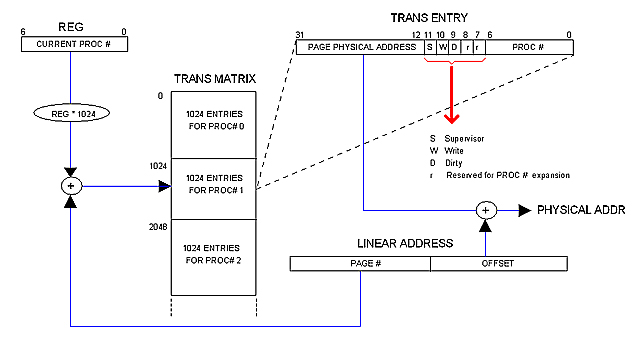First approach to Paging implementation05/23/2009
In previous note (Simplified Memory Management) I suggested that Pages Tables will take room from physical memory address space, but that is not true.
-- NOTE: --
I've borrowed most of the terminology from Intel literature but that "Pages Table" sounds ugly to me... I will call it "Translation Table" from now on, or simply "Trans Table".
-----------
I mentioned that it should be one separate Trans Table for each running process (since each process should be into believe that it owns the entire linear space). If I content my self to limit the number of simultaneous processes to a practical value, then I can afford to build a separate "room" in the CPU, out of the addressable RAM, to host all Trans Tables ever needed.
Let set the limits:
-- Max number of simultaneous processes: 128
-- Max RAM size: (Conceptually: 4 GB) expandable in steps of 4BM.
The "room" will be a SRAM matrix of 128K x 32 (using four 128K x 8 chips) expandable in steps of 128K x 32 (four chips). I will call this: the "Trans Matrix" or simply "Matrix".
Each row in the Matrix represents a Trans Table entry. With 4MB of RAM in the computer (1024 pages), 1K rows covers the entire linear space for that amount of physical memory. Therefore, with 128K rows at my disposal I can give one entire Trans Table to each of the 128 allowed processes.
As mentioned, expansion is possible (and easy). The only thing is that, as RAM expands, the Trans Matrix must be expanded accordingly. It would be better, maybe, to place the Matrix on the memory card, disributed among them in case that more than one exist.
System software is responsible for populating the Matrix. I will create the appropriate Supervisor instructions for doing that. Please notice that the Matrix needs to be updated as processes get alive and die, not only at boot up time.
Close up to the Trans Matrix
05/23/2009
The following diagram illustrates how the Trans Matrix participates in address translation and protection.
The Matrix holds a record (1024 rows deep) for each running process. Each record constitutes the process Trans Table, that is, the space available for the process to allocate the 1024 possible Trans entries.
Each process has a process number (PROC #). The current proc # is kept in certain register (REG in the diagram) as long as the process is running. That number is used as an index to access the corresponding record. The PAGE field of the Linear address is used, in turn, as an index within the record to locate the exact Trans Table entry.
As mentioned in previous notes, the Trans Entry contains the physical base address for the page in physical memory. It also contains the following control fields:
S Set if the page is for Supervisor use only
W Set if writing on this page is permitted
D Set is the page have been modified
r Reserved for future expansion
PROC # Process number
There is a reason for including the PROC #.
I mentioned in a previous note (Limitation of my one-step paging mechanism) that the Linear space available to applications is limited far below 2^32. If a buggy code submits a linear address that exceeds the limit, chances are for the Address Translation mechanism to compute an entry that is valid but belongs to the wrong process. To avoid this, the CPU will always verify that the PROC # field matches the content of REG before proceeding with Address Translation. Besides, stamping each process page with the Proc# seems to me an elegant way of assuring that inter-processes interferience will not occur.
Scalability Issue
05/25/2009
I've being thinking all the time of a static and moderate (16MB at the most) main memory distributed among different cards, 4MB each.
Lets say, however, that one day I decide to build a card with 8MB instead of 4BM. In such a case, I'll dimension the Trans Table chuck accordingly (just for that card), hence the advantage of a distributed Trans Matrix.
Problem starts when memory increases far beyond "moderation". Imagine that one day I decide to play with dynamic memory and to build a card with 256 MB of dynamic RAM. The Trans Matrix chuck for that amount of memory becomes 8M x 32, that is: 32 MB of static RAM! (about $900 at today's prices).
There are several ways for working this issue out:
1.- Reducing the limit for running processes (currently 128).
2.- Not event thinking about large amount of memory.
3.- Discarding the solution all together.
|


